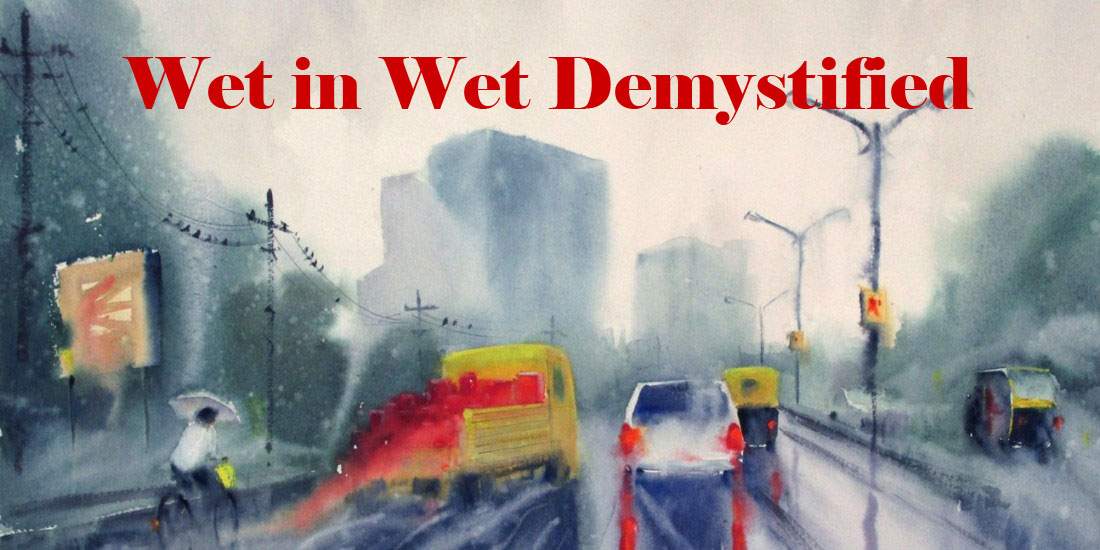In my last post on Watercolor Technique I wrote about the Watercolor Wash technique. While wash technique gives luminosity or transparency to watercolor paintings, wet paper techniques like wet in wet create mystery and softness. If Wash technique is the heart of watercolor painting then Wet in wet technique could be called soul (or vice versa). In this technique watercolor paper plays a major role in the final outcome. Paper with more surface texture (rough and cold pressed) and more cotton content (100% cotton paper works best) is suitable for this technique. But you can try this technique on hot pressed and other smooth papers also and check the results you get.
Wet in Wet Watercolor Technique
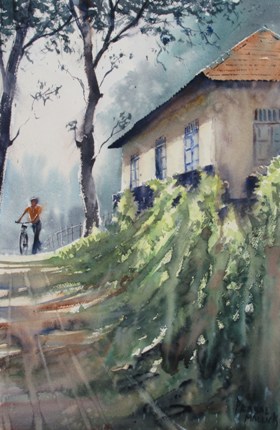
If you zoom into watercolor paper you’ll see something like a relief map with hills and plains of the watercolor paper texture. When you wet the paper the plains get flooded. It looks like a big lake with hills popping out here and there. Now if you drop some paint onto the paper, what will happen is anybody’s guess. The paint will spread in the lake in all directions. And that is exactly what wet in wet technique is all about. It is a way of spreading colors on paper automatically using water.
Here is how you can try out wet in wet technique.
- Wet your watercolor paper well using a spray or flat brush. If you are using a brush, make sure it is a soft one and touch the paper very lightly while wetting the paper.
- Take some paint in your brush and lightly ‘drop’ it on the paper. Do not press your brush hard. It will damage the surface of the paper.
- Now watch the paint spread on its own and enjoy the show.
Yes. Wet in wet technique is this easy. But the devil as always lies in the detail. Hence lets take a closer look at this. When you try this technique a few times you’ll notice that the spreading of paint is not consistent. Sometimes the paint spreads to a larger area and other times it does not spread as much. Well when the paper used is the same, the spreading of paint depends on two things.
- How heavy or light is the flooding of your landmass! In watercolor terms how wet is your paper.
- How thick or thin is the paint you are dropping.
How wet is your paper?
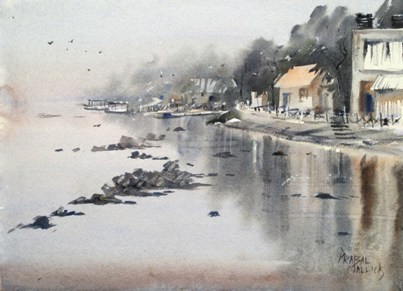
So lets first talk about different stages of wetness of the paper. The terms I am going to use are taken from this book by Joseph Zbukvic. These terms are very intuitive and are used by many watercolor artists around the world. Hence I have used them here. Why reinvent the wheel!
If you wet your paper thoroughly and then let it dry then the different stages of wetness is roughly categorized into 4 parts.
- Wet – When landmass of the paper surface including most of the hills are flooded. At this stage your paper would be glistening. In this stage paint will flow very quickly and without any control in all directions.
- Moist – In this stage the flood is not so severe. But still its a flood. Paper would be wet to touch, but not glistening so much. In this stage paint flows well, but its a controlled flow and does not spread to great distance.
- Damp – This is like a normal situation where the rivers are flowing well, but without flooding. When you place your palm on the paper, you’ll feel the moisture content of the paper. It is a stage just before the paper dries out. In this stage paint does not flow much and it also does not flow on all parts of the paper. This stage is used to create a mixture of soft and hard edges.
- Dry – In this stage the landmass of paper is barren dry. No sign of moisture whatsoever. This is your plain dry paper and hence paint will not spread at all.
How thick is your paint?
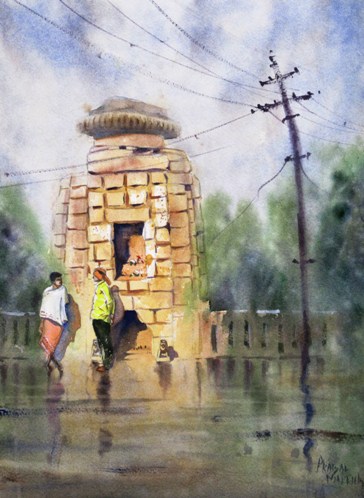
This watercolor technique also depends on how much water you add to your pigments. Here are a few terms again from the book Mastering Mood and Atmosphere to explain the paint consistency in an intuitive manner.
- Tea – Pigment to Water ratio is around 1:9. This will spread fast and without control.
- Coffee – Pigment to Water ratio is around 3:7. This will also spread well with soft edges; but not so well on damp paper.
- Milk – Pigment to Water ratio is around 1:1 This will spread well only on wet and moist paper.
- Cream – Pigment to Water ratio is around 7:3 This spreads well only on wet and moist paper. But of course it will spread less than milk.
- Butter – There is no water in this mix. Just pure paint straight out of the tube. This will tend to stick to the paper at the place it is applied and only a part of the pigments will loosen up and spread on wet paper and to some extent on moist paper.
Here is a demonstration video using different combinations paper wetness and paint consistency in watercolor wet in wet technique.
Wet in Wet Watercolor Technique Reference Table
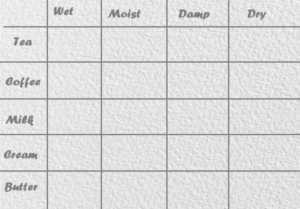
Now that you know about the different stages of wetness of paper and paint consistencies, its time for you do an exercise. By doing this exercise you’ll understand the behavior of paint for this watercolor technique and different types of edges that are produced. And then when you have the understanding of the edges, you can apply it to your work consciously.
- Create a table as shown on watercolor paper. The individual boxes should be 2 x 2 inch at least.
- Now wet the first row of the matrix using a flat brush.
- Take a tea mix and drop in the first box.
- Wait for sometimes for the paper to come to moist stage and then drop tea mix in the second box.
- Wait again for sometime for the 3rd box to come to damp stage and drop tea mix into it.
- In the last box drop the paint when paper is dry.
- When the first row has dried out wet the second row and repeat step 3 to 6 using a coffee mix.
- For 3rd, 4th and 5th row use milk, cream and butter to complete the exercise.
Now what you have is a wet in wet reference table. Use this table next time to get the edge that you want in your painting.
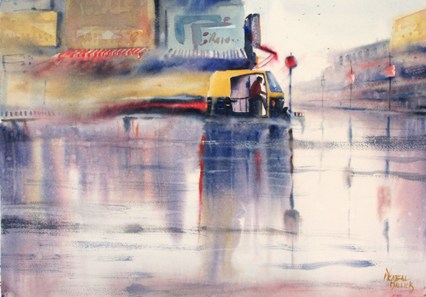
By now it must be clear to you that wet in wet watercolor technique is all about timing. You have to get a feel of how wet the paper is and how much water you have put into your paint. This ‘feel’ comes with practice. The reference table that you must make will not come out well in your first few attempts. As you practice more and get the ‘feel’ your reference table will keep improving and will be perfect at some point in time. And that is a milestone you must aim for to achieve. And when you have got a good hang of wet in wet watercolor technique, the range effects that you can get with this is limitless.

